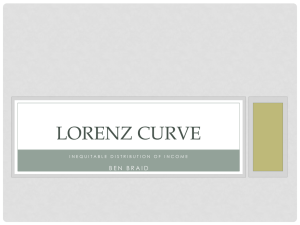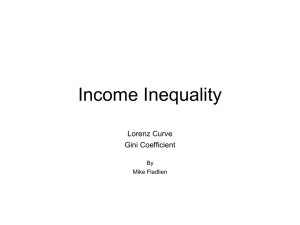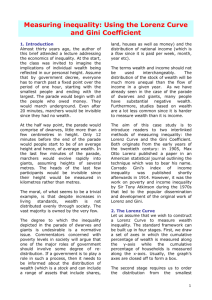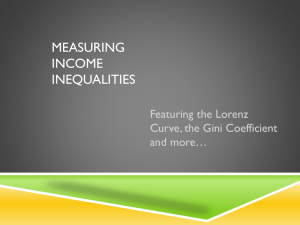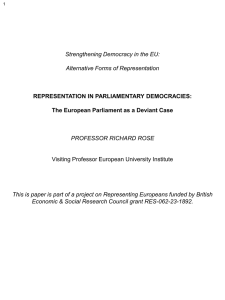PPT 1
advertisement
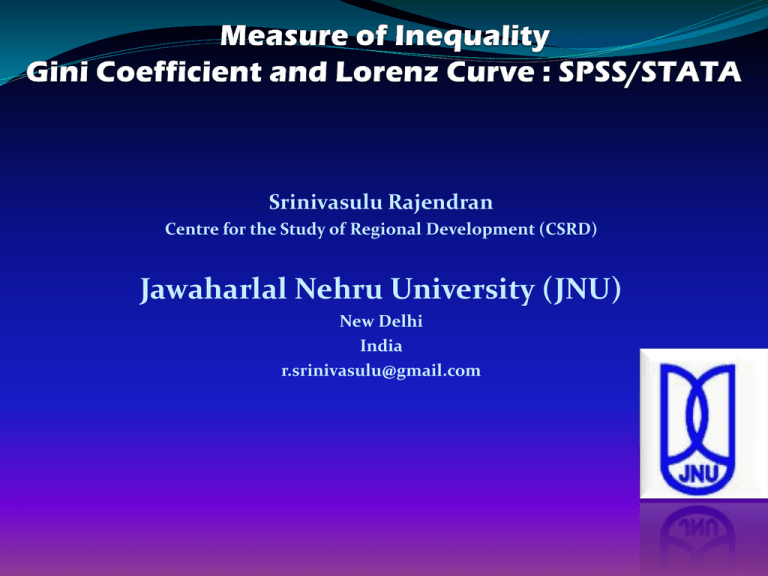
Srinivasulu Rajendran Centre for the Study of Regional Development (CSRD) Jawaharlal Nehru University (JNU) New Delhi India r.srinivasulu@gmail.com Objective of the session 1. To measure probability distribution of wealth & inequality through Lorenz Curve and Gini Coefficient 1. What is the procedure to measure wealth inequality through Lorenz Curve & Gini Coefficient? 2. How do we interpret results? What is Lorenz Curve the Lorenz curve is a graphical representation of the cumulative distribution function of the empirical probability distribution of wealth To measure wealth inequality. The Lorenz curve can give a clear graphic interpretation of the Gini coefficient. Let’s make the Lorenz curve of per capita FOOD expenditure distribution of Bangladesh. Step 1 we draw a set of axes in which the cumulative percentage of wealth is measured along the y-axis while the cumulative percentage of households is measured along the x-axis. Usually, the graph’s axes are closed off to form a box Step 2 to order the distribution from the smallest through to the largest, thereby enabling us to answer the following sequential questions: A. what proportion of wealth is owned by the poorest 10 percent of the population? B. what proportion of wealth is owned by the poorest 20 percent of the population? C. what proportion of wealth is owned by the poorest 30 percent of the population? This process continues until we reach the point where 100 per cent of wealth is owned by 100 per cent of the population. Step 3 Assume that we live in a truly equal society If this were to be the case, the relationship would be such that as we move along the x-axis, each 10 per cent increment of households would own an additional 10 per cent of wealth. In this case, the line we would draw would be a straight line emanating from the origin. This is known as the line of absolute equality and will have a slope of 45 degrees. Step 4 Finally, we can insert a line that is based on the data set available to us. In this case, the line will bow away from the line of absolute equality. The more unequal society is, the further it will deviate away from the line of absolute equality. It is this line which is known as the Lorenz Curve. Step 5 STATA Program For District 1 glcurve pcmfx if district ==1, gl(gl2) p(p2) lorenz twoway line gl2 p2 , sort || line p p , /// xlabel(0(.1)1) ylabel(0(.1)1) /// xline(0(.2)1) yline(0(.2)1) /// title("Lorenz curve") subtitle("Monthly Per Capita Food Expenditure - Manikganj") /// legend(label(1 "Lorenz curve") label(2 "Line of perfect equality")) /// plotregion(margin(zero)) aspectratio(1) scheme(economist) 1 2 Lorenz curve Monthly Per Capita Food Expenditure - Manikganj Lorenz curve Monthly Per Capita Food Expenditure - Mymensingh Lorenz curve Line of perfect equality 1 .9 .8 .7 .6 .5 .4 .3 .2 .1 0 0 .1 .2 .3 .4 .5 .6 .7 .8 .9 1 Cumulative population proportion Lorenz curve A O 3 A O 4 Lorenz curve Monthly Per Capita Food Expenditure-Kishoreganj Line of perfect equality 1 .9 .8 .7 .6 .5 .4 .3 .2 .1 0 0 .1 .2 .3 .4 .5 .6 .7 .8 .9 1 Cumulative population proportion Lorenz curve Monthly Per Capita Food Expenditure-Jessore Lorenz curve Lorenz curve A O Line of perfect equality 1 .9 .8 .7 .6 .5 .4 .3 .2 .1 0 0 .1 .2 .3 .4 .5 .6 .7 .8 .9 1 Cumulative population proportion Line of perfect equality 1 .9 .8 .7 .6 .5 .4 .3 .2 .1 0 0 .1 .2 .3 .4 .5 .6 .7 .8 .9 1 Cumulative population proportion A O Step 6 Interpretation In above figures, the line of absolute equality is labelled OA. However, the Lorenz curve assumes a different shape in the four diagrams. In Figure 2, Mymensingh District, it can be seen that the poorest sections of society command a very small proportion of the country’s wealth. In Figure 4 Jessore District, societal wealth remains unevenly distributed, but the poorer households are (on average) better off as compare to Mymensingh District. One of the advantages of using the Lorenz Curve is that it provides a visual representation of the information we wish to consider, in this case the inequality of wealth prevailing in society. We could superimpose several Lorenz Curves onto the same diagram to show changes in the way in which wealth has been distributed across society at various points in time. Even if the shape of the Lorenz Curve is not changing significantly, poorer members of society may still be much better off in terms of what they can afford to buy. In other words, they are relatively no better off, but in terms of spending power, they have the opportunity to enjoy a wider range of luxury items. Commodities which were considered to be luxuries fifty years ago (for example, televisions and telephones) are now taken for granted by most people. Hands-on exercises Now repeat this exercise based on per capita total expenditure for village adopted technology and not adopted technology and compare its Lorenz curve with the Lorenz curve for the whole area. What conclusions emerge? Now repeat this exercise per capita total expenditure for female head and male head household and compare its Lorenz curve with the Lorenz curve for the whole area. What conclusions emerge? The Gini Coefficient The Gini coefficient is to measure the degree of concentration (inequality) of a variable in a distribution of its elements. It is the ratio of the area between the Lorenz Curve and the line of absolute equality (numerator) and the whole area under the line of absolute equality (denominator). Based on Figure Four, it can be seen that the Gini Coefficient = C/0AB. Lorenz curve Monthly Per Capita Food Expenditure-Jessore Lorenz curve O Line of perfect equality 1 A .9 .8 .7 .6 .5 C .4 .3 .2 .1 0 B 0 .1 .2 .3 .4 .5 .6 .7 .8 .9 1 Cumulative population proportion Interpretation for Gini Coefficient The extreme values of the Gini Coefficient are 0 and 1. These are often presented in statistical publications as percentages. Hence, the corresponding extreme values are 0% and 100%. The former implies perfect equality (in other words, everyone in society has exactly the same amount of wealth) whereas the latter implies total inequality in that one person has all the wealth and everyone else has nothing. Clearly, these two extremes are trivial; The key thing to bear in mind is that the lower the figure that Gini Coefficient takes (between 0% and 100%), the greater the degree of prevailing equality. STATA Program Atkinson, inequal, lorenz, relsgini These four ado-files provide a variety of measures of inequality. atkinson computes the Atkinson inequality index using the inequality aversion para-meter(s) specified in the parameter list. inequal displays the following measures: relative mean deviation, coefficient of variation, standard deviation of logs, Gini index, Mehran index, Piesch index, Kakwani index, Theil entropy index, and mean log deviation. lorenz displays a Lorenz curve. relsgini computes the Donaldson-Weymark relative SGini using the distributional sensitivity parameters specified in the parameter list. “inequal” command inequality measures of pcmfx relative mean deviation coefficient of variation standard deviation of logs Gini coefficient Mehran measure Piesch measure Kakwani measure Theil entropy measure Theil mean log deviation measure .16517609 .47881288 .41682198 .23579119 .32276405 .19230475 .05184636 .09620768 .09104455 Hands-on Exercise Let’s continue using the per capita total expenditure to calculate inequality measures: i. Compute the Gini coefficient, the Theil index and the Atkinson index with inequality aversion parameter equal to 1 for the four districts. Gini Theil Atkinson All regions ________ ________ ________ District wise: ________ ________ ________ Hands-Exercise ii. Now repeat the above exercise using two decile dispersion ratios and the share of consumption of poorest 25%. STATA command xtile is good for dividing the sample by ranking. For example, to calculate the consumption expenditure ratio between richest 20% and poorest 20%, you need to identify those two groups. Reference for inequality http://web.worldbank.org/WBSITE/EXTERNAL/TOPI CS/EXTPOVERTY/EXTPA/0,,contentMDK:20238991~ menuPK:492138~pagePK:148956~piPK:216618~theSiteP K:430367,00.html
